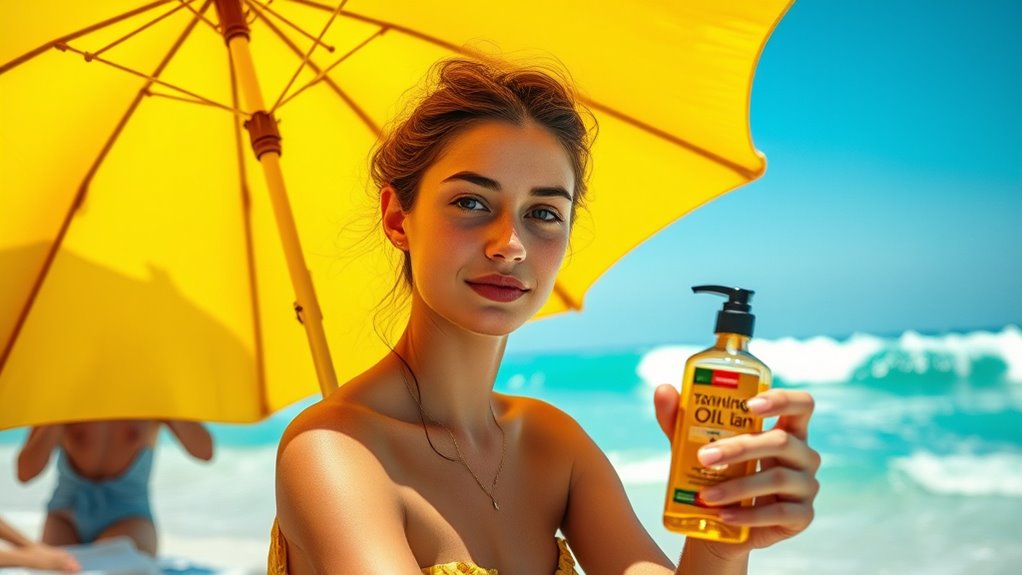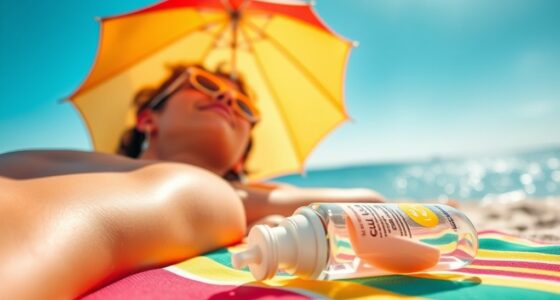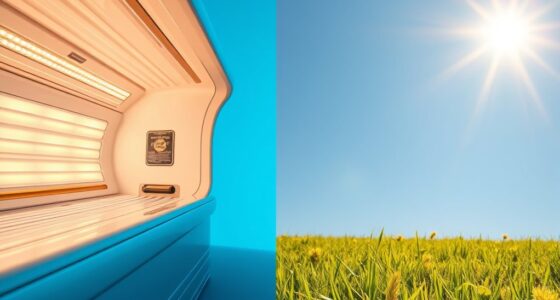Many believe a tan protects you from sun damage, but that’s a myth—tanning only shows your skin has been injured, and it offers minimal protection. Indoor tanning emits strong UVA rays that increase melanoma risk, especially before age 35. A base tan provides little help against UV rays, and tanning won’t boost vitamin D effectively. Even without burning, UV exposure causes DNA damage. Keep going to discover why avoiding tanning altogether is the safest choice.
Key Takeaways
- A tan indicates skin damage; it does not provide meaningful protection against UV rays.
- Indoor tanning beds emit mostly UVA rays, which are more harmful and increase cancer risk.
- A base tan offers minimal SPF 3–4 protection, insufficient compared to recommended SPF 30+ sunscreens.
- Tanning, even without sunburn, causes DNA damage and cellular injury over time.
- Natural sunlight and diet or supplements are safer methods for vitamin D than tanning.
The Myth of a Safe Tan From Sun Exposure

Many people believe that getting a base tan can protect them from sunburn and skin damage, but this isn’t true. A base tan is your skin’s response to UV damage, not a shield. Tanning doesn’t prevent sunburn; it only shows increased melanin production caused by skin injury. Research indicates that a base tan reduces UV radiation absorption by just 3–4%, which isn’t enough to stop skin damage. Relying on a tan can actually increase your exposure time to UV rays, raising your skin cancer risk. Remember, safe sun exposure for vitamin D production only takes about 10–15 minutes. Prolonged tanning isn’t necessary and can be harmful, leading to DNA damage, premature aging, and higher chances of skin cancer. Additionally, using appropriate sun protection can significantly reduce your risk of skin damage and skin cancer. It’s important to understand that skin injury from UV rays accumulates over time, regardless of tanning.
Indoor Tanning Versus Sun Tanning: Which Is Safer?

Both indoor tanning and sun tanning expose your skin to ultraviolet (UV) radiation, which can cause serious health issues. Tanning beds emit mainly UVA rays, with intensities up to three times stronger than natural sunlight, increasing your skin cancer risk—especially if used before age 35, raising melanoma chances by 59%. The World Health Organization classifies tanning beds as carcinogens, highlighting their danger. Sun exposure involves both UVA and UVB rays, contributing to skin damage and aging over time. While some believe indoor tanning is safer because it lacks UVB, this is false—UVA alone still harms your skin and increases cancer risk. Self-awareness about the risks associated with UV exposure can motivate better choices when it comes to skin health. Additionally, public health research indicates that the cumulative effect of UV exposure from both sources significantly impacts skin aging and cancer development. Overall, both methods pose significant health threats, and there’s no completely safe way to tan from either. UV exposure remains a major concern in both practices.
Does a Base Tan Offer Skin Protection?

Does a base tan truly protect your skin from UV damage? Not really. A base tan offers only the SPF equivalent of 3-4, meaning it delays burns slightly but provides minimal protection. The American Academy of Dermatology recommends SPF 30+—far beyond what a base tan offers. It doesn’t prevent sunburn or DNA damage, which continues to occur even with a tan. Studies show that a base tan’s low SPF provides negligible defense against UV rays, and tanning actually increases your skin cancer risk. Instead of relying on a base tan, use broad-spectrum sunscreen, wear protective clothing, or seek shade. Remember, any tan signals UV-induced cellular damage, and the idea that it shields you from future harm is a dangerous myth. Additionally, understanding the limitations of a base tan can help you make safer choices for your skin health.
The Truth About Tanning and Vitamin D

While a base tan doesn’t offer meaningful protection against UV damage, many people believe that tanning itself improves their vitamin D levels. In reality, most tanning beds emit mostly UVA light, which isn’t effective for vitamin D production. Some sunbeds with UVB can boost serum vitamin D, but natural sunlight remains the best source. However, even with regular sun exposure, vitamin D deficiency is common, and a tan doesn’t guarantee adequate levels. Melanin from tanning can actually reduce your skin’s ability to produce vitamin D. Plus, excessive sun exposure increases skin cancer risk. The safest way to maintain healthy vitamin D levels is through diet and supplements, not tanning. Additionally, understanding essential oils and their safety can help you make informed choices about skin health and overall safety practices. To further protect yourself, it’s important to consider UV exposure guidelines and limit time spent in direct sunlight. Being aware of UV radiation safety measures can further reduce your risk of skin damage. Recognizing the importance of sun protection strategies can also help minimize harm while enjoying outdoor activities. Staying informed about AI security measures is crucial as technology advances, ensuring your safety in digital environments.
Is Tanning Harmless Without Sunburn?

Is tanning without sunburn truly harmless? Not exactly. Even if your skin doesn’t turn red, UV radiation still causes DNA damage. Tanning is a sign that your cells have been injured, triggering melanin production as a protective response—yet, this indicates cellular harm. UVA rays penetrate deeper, accumulating damage over time without causing burns, while UVB also damages skin cells even without redness. Studies show that indoor tanning without burning still raises your risk of melanoma, squamous cell carcinoma, and basal cell carcinoma. Many believe a tan is safe or protective, but it’s actually a sign of damage. Sunscreen is essential regardless of whether you see signs of burning, as UV exposure silently harms your skin and increases cancer risk. Additionally, essential oils for skin health, such as lavender or tea tree oil, are sometimes used to soothe skin, but they do not prevent UV-induced damage. Moreover, UV-induced cellular injury can be ongoing even in the absence of visible skin changes, underscoring the importance of protective measures. Research also indicates that indoor tanning can cause significant skin harm, emphasizing that all UV exposure is risky.
Frequently Asked Questions
Can Tanning Be Completely Avoided Without Affecting Vitamin D Levels?
You can completely avoid tanning and still maintain your vitamin D levels. Sun exposure isn’t the only source; dietary intake of vitamin D-rich foods like fatty fish, fortified dairy, and eggs, along with supplements, can keep your levels adequate. While limited sun exposure may reduce vitamin D synthesis, you don’t have to tan or spend hours in the sun to stay healthy. Focus on diet and supplements if needed.
Are There Any Safe Alternatives to Tanning for Skin Health?
Think of safe tanning alternatives as a gentle breeze on a warm day—you get the glow without the harshness. You can opt for self-tanners, spray tans, or bronzing products, which give you a natural-looking tan without UV exposure. These options protect your skin from damage, reduce cancer risk, and keep your skin healthy. Remember to exfoliate, moisturize, and choose products suitable for your skin type for the best results.
How Does UV Exposure Differ Between Outdoor and Indoor Tanning?
You ask how UV exposure differs between outdoor and indoor tanning. Indoor tanning devices emit mostly UVA, with some UVB, often more intense than sunlight, especially UVB, which is key for vitamin D but also harmful. Outdoor sun exposure provides a mix of UVA and UVB naturally, but overexposure increases skin cancer risk. Both sources can damage your skin, so it’s best to limit UV exposure from either source for better skin health.
What Are the Early Signs of Skin Damage From UV Rays?
You might think early skin damage from UV rays is just a temporary sunburn, but it’s more subtle. Look for redness, dryness, and loss of skin elasticity around your face. Watch for fine lines, rough patches, or uneven pigmentation like freckles or dark spots. Tiny broken capillaries and thinning skin also signal damage. Spotting these signs early helps prevent more serious issues like actinic keratoses or skin cancer.
Do Certain Skin Types Have Higher or Lower Risks From Tanning?
You should know that your skin type influences your tanning risk. Fair skin (Types I and II) burns easily, so you face higher skin cancer and damage risks from tanning. Medium types (III and IV) have moderate risks, while darker skin (V and VI) tans easily and burns less, but still accumulates UV damage over time. No matter your skin type, always protect your skin to prevent long-term harm.
Conclusion
Now that you know the truth behind these tanning myths, you realize there’s no such thing as a safe tan. Sun exposure and indoor tanning can damage your skin worse than a wildfire, increasing your risk of skin cancer and premature aging. Don’t fall for the illusion that a little color is harmless. Protect your skin like it’s your most precious treasure—because, honestly, your skin’s health is worth more than any tan.









